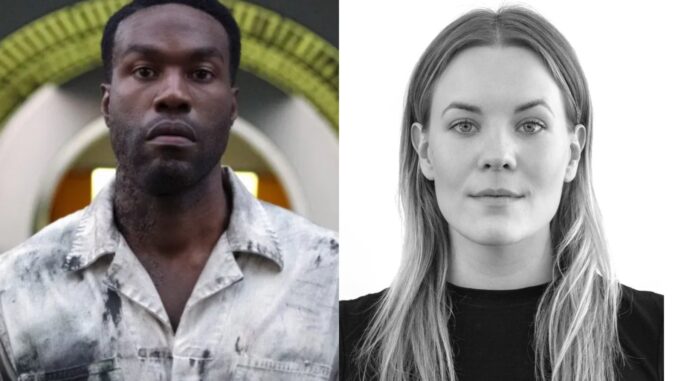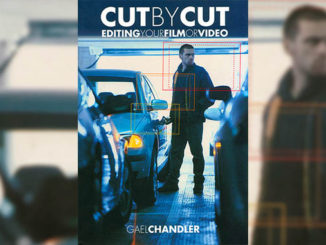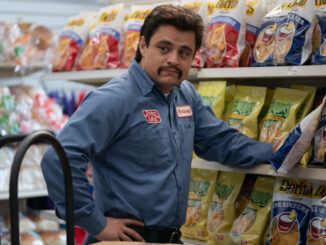
by Rob Feld
Catrin Hedström discovered movies in Sweden at age seven, when her brother showed her “The Terminator” on his 10-inch TV with built-in VHS. She noted her physical response as she crawled back, terrified, into the corner of his room—the power of cinema apparent. From then on, she was hooked.
“The first time I remember being really blown away by an editing decision was ‘American Beauty,’” she recalled. “The scene when Lester Burnham first spots Angela Hayes on the gymnasium floor, and in his imagination, she opens her shirt. The jump cuts and replays in this moment are hypnotizing. I was obsessed and replayed it over and over, being blown away by how something that shouldn’t work was so stunning and emotionally effective.”
Wanting to direct, she attended NYU Tisch School of the Arts but recalls the visceral experience of cutting 16mm reversal film on Steenbecks for her short films. “It was absolutely glorious to learn how to measure the light with a light meter, get the film back from the lab, feel the film in your hands, and cut and paste the edits together with a splicer.”
Editing jobs were plentiful when she graduated, so she took those that came, with a big break coming from her roommate, who was a producer at ad agency Droga5, when he hired her to cut social media spots and pitches for campaigns. She then started as an assistant editor on a low budget feature made by friends from NYU, but ultimately wound up cutting it, and never accepted an assistant job again, so that people would always think of her as an editor.
Hedström’s recent feature “Candyman,” directed by long-time collaborator Nia DaCosta, is a sequel to the 1992 slasher classic. Thirty years after the original film’s story ends, visual artist Anthony McCoy (Yahya Abdul-Mateen II) becomes obsessed with the urban legend of the Candyman, and explores Chicago’s Cabrini-Green housing project in search of inspiration. McCoy comes to learn that his own hidden history is in fact deeply entwined with the legend, and through a gruesome and bloody course of events, conspiracy, and supernatural transformation, he finds his own destiny as the Candyman returned.
CineMontage: You have a long history with director Nia DaCosta. How has your process developed together? What are your preproduction discussions like and how did you work together to find the voice for this film?
Hedström: Nia and I met at NYU. She was the teaching assistant in my Sight and Sound Film class. She would thread the projector and play our films in class. A couple of years later she asked me to go see a movie with her and we’ve been friends since. I remember reading a play she had done at her master program in London. It was the first script from a fellow student I had read where it was clear she knew what she was doing; the dialogue was specific to the character and there was an underlying message that came through from the story she was telling. We also spent endless time discussing films we saw, or “Walking Dead” episodes, so we know each other’s tastes well; where they meet and where they diverge. Even though I never cut anything for free for anyone else, I cut Nia’s short films for free; I believed in her as a director and as a friend I wanted to support her the best way I could. That led to me cutting her feature, “Little Woods,” which led to me cutting her two episodes on “Top Boy,” which lead me to “Candyman.” What’s great about Nia is that she knows what she wants, but she wants you to expand on it, be creative, and ad your touch. She’s open to creative ideas as long as it’s in line with the story, and she always goes for the most interesting version, which makes it fun for me. When she knows I’m fond of a detail, I usually get to keep it in. I remember Nia’s not-so-positive reaction to me putting in the take of a little boy picking a bugger out of his nose in “Little Woods.” For weeks I was convincing her it was the most perfect, genuine, and real moment and eventually she let me keep it.
CineMontage: What was the particular narrative challenge presented by “Candyman?”
Hedström: Every film has story and structure challenges, and “Candyman” was no different. Some story elements we just could not work out in the edit, so they were solved with reshoots and a couple of added scenes. Some scenes that were meant to be replaced still ended up in the film, just in a new spot. For example, the flashback of young Burke entering the bathroom where his sister just summoned Candyman, is now towards the end of the film, but originally it was the first scene of the movie.
CineMontage: “Candyman” is a supernatural thriller that moves between its suspense and slasher moments, and quieter moments of artsy Chicago social life. How did you think about pacing?
Hedström: Because the story is a mystery, I always tried my best to use the coverage in a way where I revealed information slowly. For example, staying in the profile shots of Anthony’s mother avoiding the subject of Candyman until I cut to “Don’t say that,” in a frontal shot. We don’t get to see her face until she reveals her knowledge of the myth to Anthony, and in a way reveals herself. Another time is when Anthony is inside the dilapidated Cabrini apartment for the first time. He spots something on the wall but I don’t reveal what has captured his interest until he has picked up his camera and takes a picture; the camera flashes on the wall and reveals a graffiti of Candyman. I extended the red focus laser from his camera as much as I could, as red light signifies a warning. Another moment is when Candyman is speaking to the cop inside the car at the end. He walks around the car and stands in front, facing the cop in the driver’s seat. I played his disappearance after by staying on the cop and his reaction to Candyman being gone, rather than on Candyman disappearing in front of us, keeping the audience guessing, even if it’s just for a beat.
CineMontage: How did you and the team integrate sound to boost the story?
Hedström: I used sound to cue the audience for when something bad was about to happen; when Anthony climbs the fence at Cabrini the first time, I fade out the city and the new construction noise—which we always hear in the apartment and close vicinity—and fade in crickets, so that you feel he’s almost entered a different dimension just by stepping his foot inside the perimeter. I kept using bugs as a sound motif. I’m not sure if Michael Babcock kept this detail as he took over sound, but before any horror event, the sound of the crickets would ramp-up and change. It’s a subtle but effective subconscious cue, sort of like dogs barking before humans know there is a threat. I also added police sounds here and there so we felt their looming presence more throughout the film. When Anthony leaves his apartment for the first time and we’re right outside his building, Yahya did this little double-take, looking behind him, in one of his takes. I used that take and added a cop car sound, so that the glance is him reacting to the cop. There is another police car sound when Anthony is in Burke’s Laundromat and is first hearing the Candyman story. Again, there was a great take of Yahya where he did this little glance out towards the street, and I added another cop car sound there. That cue works well with the dialogue there, too.
CineMontage: How did your edit choices enhance the supernatural character of the movie?
Hedström: To enhance the supernatural and horror, I’d cut where things would feel a bit “off.” There is a big wide shot of Anthony crossing a road inside of Cabrini. I cut out of the shot as he disappears behind a pole, and extended the time by using a split screen so that he never comes out on the other side of it. Rather than cutting as he goes behind a building, or match cutting to another shot, having him disappear behind something randomly felt just a little disturbing. It’s just a little strange, but little details like that create a vibe. I can’t remember if the score changed here, but for most of the cut there was also a sort of “swoop/suction” sound I found in one of Robert’s early cues to emphasize this moment. All this is trying to keep the audience on edge.
CineMontage: Did the original “Candyman” influence you?
Hedström: When Nia first got the job, I watched the original “Candyman.” I was blown away by the storytelling, especially in the first third of the film where Helen Lyle is being drawn in by the myth of Candyman. There were lots of beautiful cross-dissolves in this part of the film, a tool I absolutely love working with when the story calls for it as it, and I told Nia I definitely wanted to play with that as homage to the original. Let’s just say I don’t think she was on board with that idea immediately, but I was determined. Then one day early in production, I get this shot of a slow pan across the city and old Cabrini, that eventually lands on Anthony painting in his studio. I also got a few close-ups of paint cans and one shot of a paint stroke across a blank canvas. As I was messing around with the scene, it occurred to me that the stoke of the paintbrush and the pan was essentially the same speed and going in the same direction. I tried cross-dissolving it and I got so excited about the result I ran down to show my assistant immediately, jumping up and down with joy. It goes well with some of the original “Candyman” dialogue, “I am the writing on the wall,” and as a tool for Anthony becoming increasingly hypnotized by the myth. It’s also perfect story-wise. It was just meant to be and I’m so happy I found it.
CineMontage: Was there a management challenge to this size production?
Hedström: The second film I cut, “#Horror,” was a horror with over 300 VFX shots and three vendors. At the time I was cutting it, I didn’t have an AE and there was no producer or post sup on the film during the vast majority of post. For 11 months I was the one managing post; the edit, VFX, vendors, and all of its challenges. So, I had that unusual VFX experience behind me. “Candyman” was my first film with an editing team larger than just one or two assistants. I remember the first time talking to my VFX editor Scott. I straight up let him know; I’ve never had a VFX editor before so you’ll have to tell me how this works. In my experience, things work better when you are upfront with your level of knowledge. I’ve seen people pretend they know more than they do, and that tends to crash and burn. Since English is my second language and I lived my whole adult life in a foreign country, I’m constantly asking people, “What does that mean?” So I’m used to asking the “stupid” questions; and I had plenty of those. I’m grateful to have done “Candyman,” a sort of medium level VFX film, before heading in to “The Marvels,” which is more or less all VFX shots.
CineMontage: You have since cut Lena Dunham’s “Sharp Stick” and now you’re cutting “The Marvels.” Is there a whiplash between styles for you?
Hedström: In a way, every film has the same process, no matter the material. The editor is essentially the first audience member to a scene. When I cut something, I’m watching the takes, then the edit of the scene, then the entire structure of the film; and in each step I’m constantly asking myself what I’m feeling; are my feelings in line with what this line/scene/story is attempting to communicate or evoke? So when something is sad, dramatic, horrifying, exciting, fun, etc., I’m riding those emotions in the cutting room constantly. If I’m not feeling the scene, it’s not working, and it is my job to expand the emotion as much as possible with sound and score. What I’ve realized, having worked on many different genres, is that as the editor you really become the material. It can be emotionally hard to all day, every day, dive creatively into dark and difficult subjects; and looking at and listening to moody and harsh sounds. So, after the difficult subjects we tackled in “Candyman,” it was good for me to switch to comedy. Lena’s material is hysterically funny, but also incredibly vulnerable and relatable. Lena is also a very generous director and encouraging of creativity. So far, “The Marvels” is proving to be a very fun edit. The Marvel Universe is such a creative and imaginative space, which is a fun place to visit every day.
CineMontage: How does music impact your cut?
Hedström: We use a lot of music in “Sharp Stick. Lena already had a playlist of music that had inspired her as she was writing the film, and she sent me that playlist before I started cutting dailies. I used a lot of that music. I love having options to play with in the edit early on, rather than it being pasted on after I’ve already locked the cut. The music helped me find the tone and the language of “Sharp Stick,” and some scenes are better for it. “Candyman” was a similar experience with the score; Robert already had beginnings of his score—at that point mostly tones and sounds—when I started cutting. It was so helpful to use those early versions in my first cuts, and I almost never had to use temp score. Robert would stay in touch and ask what I was using, what was working with the footage and wasn’t working, and he’d keep developing his score based on that. Throughout the entire editing process, he was sending me new music as he was creating it, with no particular placement in mind, and as I found its home, he would update it to fit the scene perfectly later on. I really loved working with Robert this way. He creates with such deep consideration to the material, and I could not imagine the film without his music.






